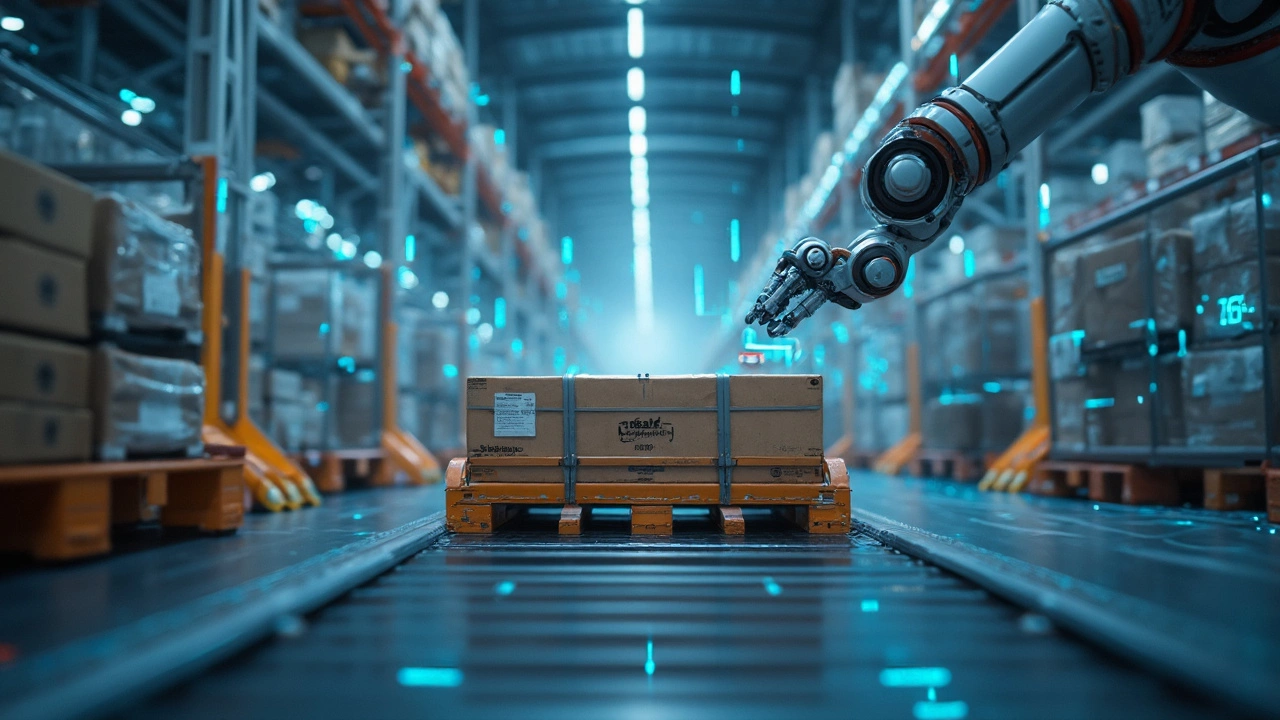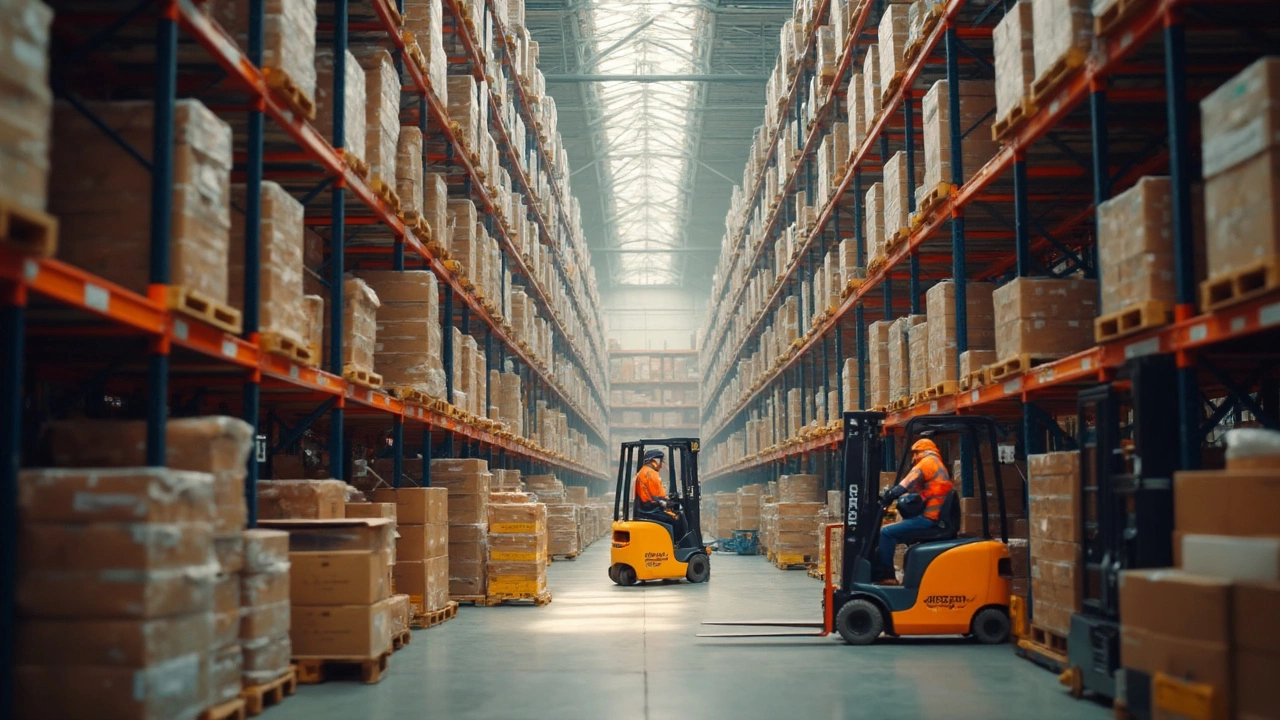Ever imagined how that favorite item of yours zips through Amazon's massive system to land at your doorstep? A big part of it is pallet delivery. It’s not as mysterious or complicated as it sounds. Essentially, it's all about stacking products on a wooden or plastic pallet to move them around with ease. You know those flat wooden platforms you often see in warehouses? That's a pallet, and it’s a lifesaver for bulk shipping.
Amazon's choice to lean heavily on pallet delivery isn’t random. When you’re moving as many packages as they do, efficiency is your best mate. By using pallets, they can shift loads of products quickly, keeping everything organized and controlled. Imagine trying to move a thousand small boxes one by one; it’s a no-go, right?
- Understanding Pallet Delivery Basics
- Why Amazon Uses Pallet Delivery
- Benefits of Pallet Delivery
- Pallet Delivery Tips for Sellers
- Common Challenges and Solutions
Understanding Pallet Delivery Basics
Alright, let's get into what pallet delivery really means. At its core, pallet delivery is just moving goods stacked on a pallet. It's a straightforward concept, but it's a game-changer for anyone dealing with bulk shipments or heavy items.
A pallet is typically a flat structure made of wood, plastic, or metal, and it acts like a foundation to stack, store, and move products around. Why bother with pallets? Well, they save time and effort. Think about it: you can move entire stacks of boxes all at once with a forklift rather than heaving them around one by one.
Types of Pallets
Pallets come in several forms, but the most common ones you'll find are wooden and plastic pallets. Wooden pallets are pretty popular because they're cheap and durable. Plastic pallets, on the other hand, may cost more but offer resistance to chemicals and weather, making them a solid choice for specific industries.
The Role in Shipping
In the logistics world, pallets make it easier to move large quantities of items. For Amazon specifically, this means a more organized, swift, and efficient way to get things from point A to point B. You'll find pallets in warehouses, on freight trucks, and even in planes—wherever bulk shipping is necessary.
Advantages of Pallet Delivery
- Speed: It’s way faster to move a pallet-load compared to individual boxes.
- Safety: Reduces the risk of damage during transit by keeping items in one secure spot.
- Cost-Efficiency: Saves money on labor and reduces the number of trips needed to transport goods.
| Type of Pallet | Material | Durability |
|---|---|---|
| Wooden | Wood | High |
| Plastic | Plastic | Very High |
| Metal | Metal | Extremely High |
Understanding these basics can help anyone in the shipping or ecommerce industry make smarter decisions when it comes to moving their products. Whether you're a seller on Amazon or just curious, knowing a bit about pallet delivery puts you a step ahead in the logistics game.
Why Amazon Uses Pallet Delivery
Amazon's choice to use pallet delivery didn't happen overnight. It’s a well-thought strategy to keep up with the pace of enormous demands. This system is all about efficiency, cost-effectiveness, and keeping chaos at bay in those sprawling warehouses.
Efficiency in Movement and Storage
By stacking items on pallets, Amazon can swiftly load and unload goods using forklifts. Imagine trying to organize thousands of individual products by hand—it would be a nightmare! Instead, pallets allow for batches of products to move together, saving both time and manpower.
Cost-Effectiveness
Frequent small shipments cost more than sending larger loads on pallets. With pallet delivery, Amazon minimizes the number of trips required to move inventory, which helps cut down on fuel and labor costs. It’s like carpooling for packages.
Reducing Damage and Loss
When items are stacked haphazardly or shipped individually, they’re at risk of getting damaged. Pallets provide a solid foundation, keeping products stable and safe. It’s kind of like giving your package an extra layer of protection.
| Benefit | Reason |
|---|---|
| Better Organization | Keeps products neat and easy to track |
| Time Savings | Quick loading and unloading |
| Cost Savings | Reduced trips and manpower |
So, next time that Amazon order arrives at your door, think about the journey it took. Thanks to smart strategies like pallet delivery, your package arrived safely and quickly! Almost like magic, but with a lot of smart planning behind it.

Benefits of Pallet Delivery
So, why is pallet delivery such a big deal for Amazon? For starters, it's all about making things simple and fast. Imagine trying to handle dozens of small boxes in a busy warehouse; pallets act like the superheroes here by bundling everything together. This means less time spent moving items around, which is good news for both speed and efficiency.
Logistics companies, like the ones working closely with Amazon, love pallets because they reduce the amount of floor space needed. Stack 'em high and tight, and you’re saving room and money. Plus, by using pallets, you avoid the risk of damaging items as they’re moved. Less handling means fewer mishaps, which is always a win.
Cost-Effectiveness
Using pallet delivery can also save some pennies. Transporting goods in bulk is often cheaper than shipping loads of little packages separately. It’s a bit like buying in bulk at your local supermarket; you get a better deal per unit.
Environmental Friendliness
Believe it or not, pallet use can be a greener choice. By cutting down on the number of individual shipments, the overall carbon footprint is reduced. Also, most pallets are reused or made from sustainable materials, aligning with eco-friendly practices.
Streamlined Inventory Management
From an inventory angle, pallets make it easier to track goods. Everything’s together in one place, so it’s less likely you’ll lose track of a shipment. For anyone selling on Amazon, this organized system helps keep tabs on stock, ensuring you’re never caught out when those orders come rushing in.
All in all, pallet delivery isn’t just an efficient way to move products; it’s a critical part of keeping costs down and productivity up for big players like Amazon. It’s like having a cheat code for modern logistics.
Pallet Delivery Tips for Sellers
Diving into pallet delivery with Amazon can streamline your operations massively, but getting it right requires some know-how. Let's break down some handy tips to keep your shipments smooth and efficient.
1. Choose the Right Pallet
Starting with the basics, make sure your pallets are sturdy and standard-sized—usually 48x40 inches. The right pallet will protect your goods during transit and help avoid damage claims. Opt for wood or plastic depending on your needs but ensure they meet Amazon's shipping guidelines.
2. Proper Stacking and Wrapping
When stacking items on a pallet, heavier items should be at the bottom. Use a crisscross pattern for stability. Properly wrapping pallets with stretch film is crucial to secure your load. A loose wrap can lead to shifting items and potential damage.
3. Labeling is Key
Make sure each pallet is clearly labeled with Amazon's shipping labels. This isn't just for the folks at the warehouse; it aids in tracking and ensures your items end up in the right place. Correct labeling reduces processing time and errors.
4. Know the Regulations
Understand Amazon's specific freight requirements concerning height and weight limits as exceeding these can lead to delays or additional fees. Knowing the rules saves you from unexpected surprises down the line.
5. Schedule Deliveries Wisely
Timing is everything. Plan your shipping based on Amazon's warehouse schedules to avoid congestion. Try to book deliveries during less busy periods if possible. Consistency with scheduling helps maintain a positive partnership with logistics providers.
Extra Tip: Keep an Eye on Costs
Shipping costs can add up, so consider using tools or platforms that compare different logistics providers. Optimizing shipment size and frequency can lead to major savings.
By keeping these tips in check, you’re not only making your life easier but also leveraging Amazon's logistics power to the fullest. Try them out and see smoother shipments heading out from your business!

Common Challenges and Solutions
When it comes to pallet delivery in Amazon's complex network, things don’t always go without a hiccup. There are a few bumps in the road you should be prepared for, but rest assured, there are solutions to tackle them.
Challenge 1: Damaged Goods
One huge concern is damaged goods during transit. Picture your neatly stacked pallet tipping over! The impact can be nerve-wracking, especially when dealing with fragile items.
Solution: Always ensure goods are secured tightly on the pallet. Wrapping them with stretch film and using corner protectors can dramatically reduce the chance of damage. Better yet, reinforce the stability by evenly distributing the weight.
Challenge 2: Shipping Delays
Nobody likes delays, least of all your customers. Sometimes, pallets are stuck due to unexpected logistics bottlenecks.
Solution: Plan your shipments ahead of time and track them regularly. Communicate with Amazon’s logistics team if you spot any anomalies. Keeping your communication channels open can expedite resolutions.
Challenge 3: Incorrect Labeling
Pallets need to be correctly labeled or they might end up on a journey to the completely wrong location. This is a classic, but avoidable mishap.
Solution: Double-check all the labels before the pallet hits the road. Make sure to include the correct address, barcodes, and any special instructions. It’s simple: less assumption, more confirmation.
Accuracy and Precision in Logistical Processes
| Challenge | Percentage of Occurrence |
|---|---|
| Incorrect Labeling | 15% |
| Damaged Goods | 20% |
| Shipping Delays | 25% |
Remember, these issues are part of the game and with each resolved challenge, your logistics skills sharpen. So keep your expectations patched up with protocols, and you’ll be on a smoother path with your pallet delivery ventures in the vast Amazon universe.


